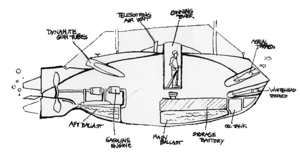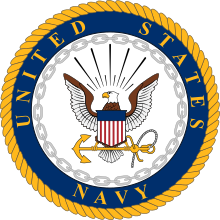USS Holland (SS-1)
USS Holland (SS-1) was the United States Navy's first modern commissioned submarine, although not the first military submarine of the United States, which was the 1775 submersible Turtle. The boat was originally laid down as Holland VI at the Crescent Shipyard of Elizabeth, New Jersey for John Holland's Holland Torpedo Boat Company, and launched on 17 May 1897. She was acquired by the USN on 11 April 1900 and commissioned on 12 October 1900, Lieutenant H. H. Caldwell commanding.[1][2]
 USS Holland (SS-1) underway | |
| Class overview | |
|---|---|
| Operators: |
|
| Preceded by: | none |
| Succeeded by: | Plunger class |
| History | |
| Name: |
|
| Namesake: | John Philip Holland |
| Builder: | Crescent Shipyard, Elizabeth, New Jersey |
| Laid down: | November 1896 |
| Launched: | 17 May 1897 |
| Acquired: | 11 April 1900 |
| Commissioned: | 12 October 1900 |
| Decommissioned: | 17 July 1905 |
| Stricken: | 21 November 1910 |
| Fate: | Sold 18 June 1913; on display in a park in Paterson, New Jersey until sold for scrap, 1932 |
| General characteristics | |
| Class and type: | Submarine |
| Displacement: |
|
| Length: | 53 ft 10 in (16.41 m) LOA |
| Beam: | 10 ft 4 in (3.15 m) extreme |
| Draft: | 8 ft 6 in (2.59 m) |
| Installed power: |
|
| Propulsion: |
|
| Speed: |
|
| Range: | |
| Test depth: | 75 feet (23 m) |
| Complement: | 6 |
| Armament: |
|
Design and construction

Holland was built at former Navy Lieutenant Lewis Nixon's Crescent Shipyard of Elizabeth, New Jersey for John Holland's Holland Torpedo Boat Company, which became the Electric Boat company in 1899.[3] The vessel was built under the supervision of John Philip Holland, who designed the vessel and her details. Holland's keel was laid at Nixon's Crescent Shipyard with both men present. The two men worked together using many of John Holland's proven concepts and patents to make the submarine a reality, each man complementing the other's contributions to the development of the modern submarine. John Holland was the inventor for US Patent 702,729 for the design of a submarine boat. [4] Important contributions were also made by Arthur L. Busch (or Du Busc), Crescent's superintendent.
Holland VI included many features that submarines of the early 20th century would exhibit, albeit in later, more advanced forms. There was a conning tower from which the boat and her weapons could be directed. Also, she had all the necessary ballast and trim tanks to make precise changes in depth and attitude underwater. Her crew was six men and maximum diving depth was 75 feet (23 m).[5]
For armament, she had a reloadable 18.01 inch (457 mm) torpedo tube with three torpedoes and an 8.425-inch (214.0 mm) pneumatic dynamite gun in the bow (the dynamite gun's projectiles were called "aerial torpedoes").[6] A second dynamite gun in the stern was removed in 1900 to make room for an improved engine exhaust, prior to delivery to the Navy.[7]
She had both an internal combustion engine (specifically, a 4-stroke Otto gasoline engine of 45 bhp (34 kW)) for running on the surface and charging batteries, and an Electro Dynamic electric motor of 50 shp (37 kW) for submerged operation, with one shaft.[8] A 66-cell Exide battery powered the electric motor when submerged.[5] This allowed speeds of 6 knots (11 km/h; 6.9 mph) surfaced and 5.5 knots (10.2 km/h; 6.3 mph) submerged. Surfaced range was 200 nmi (370 km; 230 mi) at 6 kn (11 km/h; 6.9 mph), while submerged range was 30 nmi (56 km; 35 mi) at 5.5 kn (10.2 km/h; 6.3 mph).[5] There is significant variation in references as to the vessel's horsepower and speed, for example the Register of Ships of the U. S. Navy gives horsepower figures of 45 bhp (34 kW) surfaced and 75 shp (56 kW) submerged, with 8 knots (15 km/h; 9.2 mph) surfaced and 5 knots (9.3 km/h; 5.8 mph) submerged.[6]
Service
Holland VI eventually proved her validity and worthiness as a warship and was ultimately purchased by the U.S. government for the sum of $150,000 on 11 April 1900. She was considered to be the first truly successful craft of her type. The United States Government soon ordered more submarines from Holland's company, which were to be known as the Plunger class. These became America's first fleet of underwater naval vessels.
_-_Scientific_American_1898.jpg)
Holland VI was modified after her christening, and was renamed USS Holland (SS-1) when she was commissioned by the US Navy on 12 October 1900, at Newport, Rhode Island, with Lieutenant Harry H. Caldwell in command.[2]
Holland was the first commissioned submarine in the US Navy[9] and is the first of the unbroken line of submarines in the Navy. She was the fourth submarine to be owned by the Navy, however. (The first submarine was Propeller (also known as Alligator), the second was Intelligent Whale and the third was Plunger, an experimental submarine, built in 1895, which is not to be confused with USS Plunger (SS-2).
._Starboard_bow%2C_on_ways%2C_1900_-_NARA_-_512954.tif.jpg)
On 16 October 1900, in order to be kept serviceable throughout the winter, Holland left Newport under tow of the tug Leyden for Annapolis, Maryland,[9] where she was used to train midshipmen of the United States Naval Academy, as well as officers and enlisted men ordered there to receive training vital in preparing for the operation of other submarines being built for the Fleet.[2]
Holland proved valuable for experimental purposes in collecting data for submarines under construction or contemplation. Her 166 mi (267 km) surface run, from Annapolis to Norfolk, Virginia from 8–10 January 1901, provided useful data on her performance underway over an extended period.[2]
Holland (briefly in 1899, on trials)[7] and five Plunger class Holland-type submarines were based in New Suffolk, New York on the North Fork of Long Island from 1899–1905, prompting the hamlet to claim to be the first submarine base in the United States.[10]
Except for the period from 15 June to 1 October 1901, which was passed training cadets at the Naval Torpedo Station, Newport, Rhode Island, Holland remained at Annapolis as a training submarine until 17 July 1905 when she was decommissioned.[2]
Holland finished her career in reserve at Norfolk, Virginia. Her name was struck from the Naval Vessel Register on 21 November 1910.[1] This revolutionary submarine was sold as scrap to Henry A. Hitner & Sons of Philadelphia on 18 June 1913 for $100. Her purchaser was required to put up $5,000 bond as assurance that the submarine would be broken up and not used as a ship.[2]
About 1915 the hulk of the Holland, stripped of her external fittings, was sold to Peter J. Gibbons. As of October 1916 she was on display in Philadelphia.[11] In May 1917 she was moved to the Bronx, New York as a featured attraction at the Bronx International Exposition of Science, Arts and Industries.[12]
Holland was on display for several years in Paterson, New Jersey until she was finally scrapped in 1932.[1]
See also
| Wikimedia Commons has media related to USS Holland (SS-1). |
- History of submarines
- Plunger (experimental submarine)
References
- Friedman, p. 286
- "Holland I (SS-1)". Dictionary of American Naval Fighting Ships. Navy Department, Naval History and Heritage Command. 20 July 2015. Retrieved 17 May 2016.
- "Crescent Shipyard". GlobalSecurity.org. Retrieved 21 September 2012.
- https://patents.google.com/patent/US702729A/
- Friedman, p. 306
- Bauer and Roberts, p. 253
- Friedman, p. 25
- Gardiner and Gray, pp. 126-127
- Morris
- "History of Cutchogue-New Suffolk". cutchoguenewsuffolk.org. Archived from the original on 29 April 2006. Retrieved 4 November 2007.
- Ward County Independent, 26 October 1916. pg. 1.
- New York Tribune. May 25, 1917.
- This article incorporates text from the public domain Dictionary of American Naval Fighting Ships. The entry can be found here.
Bibliography
- Bauer, K. Jack; Roberts, Stephen S. (1991). Register of Ships of the U.S. Navy, 1775-1990: Major Combatants. Westport, Connecticut: Greenwood Press. ISBN 0-313-26202-0.
- Franklin, Roger (1986). The Defender: The Story of General Dynamics. Harper & Row.
- Friedman, Norman (1995). U.S. Submarines Through 1945: An Illustrated Design History. Annapolis, Maryland: Naval Institute Press. pp. 285–304. ISBN 1-55750-263-3.
- Gardiner, Robert; Gray, Randal (1985). Conway's All the World's Fighting Ships, 1906-1921. London: Conway Maritime Press. ISBN 0-85177-245-5.
- Morris, Richard Knowles (1998). John P. Holland, 1841–1914: Inventor of the Modern Submarine. University of South Carolina Press. ISBN 978-1-57003-236-3. Retrieved 12 February 2008.
Further reading
- International Directory of Company Histories. 86. The Thomson Gale Group/St. James Press. July 2007. pp. 136–139. Listed under the heading of General Dynamics/Electric Boat Corporation.
- Morris, Richard Knowles, PhD (October 1998). "Who Built Those Subs?". Naval History Magazine. Annapolis, Maryland: United States Naval Institute (125th Anniversary).
- Steel Boats, Iron Men: The History of the United States Submarine Force. Paducah, Kentucky: Turner Publishing Company. 1994. pp. 37–39. ISBN 978-1-56311-081-8.
- Compton-Hall, CDR Richard, MBE RN (1999). The Submarine Pioneers. Sutton Publishing LTD. UK.
- Rodengen, Jeffery (2007) [1994]. The Legend of Electric Boat, Serving The Silent Service. Write Stuff Syndicate.
- The Klaxon. New London/Groton, Connecticut: The Nautilus Memorial Submarine Force Library and Museum. April 1992. Missing or empty
|title=(help) The US Navy's official submarine force newsletter. Article is about Arthur Busch/Du Busc and his key role in building America's (and Japan's) first submarines, circa 1896–1905. US Navy Submarine Force Library and Museum - "Arthur L. Du Busc, Submarine Pioneer, dies (at 90); Builder of First Craft Accepted by the United States". The New York Times. 11 March 1956. Retrieved 21 September 2012.(subscription required)
- Documents and letters written by John Philip Holland, Lewis Nixon and Elihu B. Frost, etc. archived and housed at the US Navy Submarine Force Library and Museum in New London, Connecticut
External links
- Photo gallery of USS Holland at NavSource Naval History
- "Submarine Pioneers". Chief of Naval Operations Submarine Warfare Division.
- "John Philip Holland (1841–1914) And His Submarines". Archived from the original on 26 October 2009. This site also contains information on Elihu B. Frost, Arthur L. Busch, Frank Cable, Lawrence York Spear, Isaac Rice etc.
- Hamilton, Robert A. "Morris view of Holland more widely accepted in our era". The Day. Archived from the original on 16 October 2006.
- "SS-1 Holland". GlobalSecurity.org.
- Mattera, Phil. "General Dynamics". corpwatch.org. This site attempts to further explain the events that took place while John P. Holland's company was being formed.
- DiGiulian, Tony Navweaps.com Dynamite Guns page
